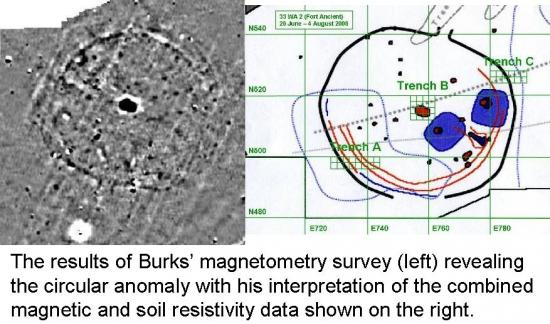Archaeology | Technology offers peek into past
Bradley T. Lepper
Source - http://www.dispatch.com/content/stories/science/2012/01/22/technology-offers-peek-into-past.html

This image of the Shriver Circle includes magnetometry data. – Jarrod Burks
When friends ask me what’s new at work, I occasionally (often enough to become tiresome) respond with, 'Nothing. Everything I work with is old.'
But that’s not entirely true. In archaeology, as in any field of science, there is always something new — whether it’s a new discovery or the development of new technologies that enable us to learn new things about old discoveries.
Ohio’s ancient earthworks certainly aren’t news. The Smithsonian Institution’s first publication, in 1848, included surveys of most of the largest sites.
Sadly, since then, many of these wonderful sites have been plowed over or leveled to make way for houses, stores and factories. For example, the authors of the Smithsonian report concluded, with regard to Newark’s once-sprawling earthworks, “The ancient lines can now be traced only at intervals, among gardens and outhouses.”
In the October issue of the journal American Antiquity, two Ohio archaeologists — Jarrod Burks, with Ohio Valley Archaeology Inc., and Robert Cook, from Ohio State University — presented the results of their rediscovery of some of Ohio's lost earthworks using revolutionary remote-sensing technology.
Geophysical remote sensing encompasses a variety of methods for “seeing” beneath the ground. One of the main instruments used by Burks and Cook is the fluxgate magnetometer, which measures tiny variations in the magnetic properties of soil.
Earthworks generally are quite large, and building one involved the rearrangement of large amounts of soil. Wherever soil has been disturbed, the baseline magnetic field is disrupted, and the magnetometer can detect these anomalies. The magnetic “signature” of earthworks usually is highly visible and distinctive.
A case in point is the Shriver Circle, one of the largest circular enclosures ever built in the Ohio Valley. It was mapped by Smithsonian surveyors and was known to be located about 2.5 miles north of Chillicothe. But decades of farming and other development had largely obliterated it from the landscape.
In 2008, Burks and Cook conducted a magnetometry survey of much of the circle — even getting permission to spend a day surveying within the grounds of the Chillicothe Correctional Institution. The results are amazing.
Even though little if anything can be seen of the enclosure on the ground, the magnetic data revealed its graceful lines in exquisite detail.
Burks and Cook concluded that the foundations of the earthwork and its filled-in ditch were “ quite intact and could be detected even in areas of intensive building construction and demolition.”< /p>
By revealing precious remnants of earthworks once considered to be lost forever, remote-sensing technology gives us a second chance to learn the stories of these ancient sites.
These data can be used to produce more-accurate maps and to more precisely target archaeological excavations, guide restoration efforts or identify sites for preservation.
Burks and Cook say these new methods are “considerably refining our view of the earthworks of Ohio.” More than that, they are fundamentally changing the way we do archaeology.
Bradley T. Lepper is curator of archaeology at the Ohio Historical Society.
